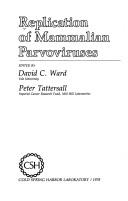| Listing 1 - 9 of 9 |
Sort by
|

ISBN: 0387813551 3211813551 Year: 1976 Publisher: Wien : Springer,
Abstract | Keywords | Export | Availability | Bookmark
 Loading...
Loading...Choose an application
- Reference Manager
- EndNote
- RefWorks (Direct export to RefWorks)

ISBN: 0306414120 Year: 1984 Publisher: New York : Plenum Press,
Abstract | Keywords | Export | Availability | Bookmark
 Loading...
Loading...Choose an application
- Reference Manager
- EndNote
- RefWorks (Direct export to RefWorks)

ISBN: 3805569467 3318004871 Year: 2000 Publisher: Basel ; New York : Karger,
Abstract | Keywords | Export | Availability | Bookmark
 Loading...
Loading...Choose an application
- Reference Manager
- EndNote
- RefWorks (Direct export to RefWorks)
Parvovirus infections. --- Parvoviruses. --- Parvoviridae --- Gene Transfer. --- Genetic Vectors. --- Parvoviridae Infections. --- genetics. --- pathogenicity.

ISBN: 0879691204 Year: 1978 Publisher: Cold Spring Harbor (N.Y.) : Cold Spring Harbor laboratory,
Abstract | Keywords | Export | Availability | Bookmark
 Loading...
Loading...Choose an application
- Reference Manager
- EndNote
- RefWorks (Direct export to RefWorks)
Parvoviruses --- Viruses --- Mammals --- Host-virus relationships --- Congresses. --- Reproduction --- Congresses. --- Diseases --- Congresses. --- Congresses.
Book
Abstract | Keywords | Export | Availability | Bookmark
 Loading...
Loading...Choose an application
- Reference Manager
- EndNote
- RefWorks (Direct export to RefWorks)
The increased international transportation and trade over the last few decades have increased the risk of the introduction of pathogens into new areas. Global climate change has influenced environmental conditions and the ability of pathogens to survive, and has changed the habitats of certain vectors and hosts. These processes have led to the emergence or re-emergence of various pathogens in different parts of the world, including those affecting horses. This Special Issue features some aspects regarding several well recognized as well as some new and emerging equine viral pathogens, highlighting the need for updated epidemiological data. Such surveillance is crucial for proper decision making by clinicians and by regulatory authorities. Also demonstrated by the recent global emergence of SARS-CoV-2, the development of an effective infrastructure for the rapid and effective detection and control of novel viral pathogens, as well as re-emerging ones, is essential. Horses should play an important role in such surveillance systems, not only for equine pathogens but also as sentinels to other viruses and arboviruses. As was demonstrated in several examples in this Special Issue, it is important to remember, both as clinicians and as researchers, that when facing clinical cases, even when those are common, we should remain alert to the possibility of the intrusion of unknown pathogens and, therefore, should seek a definitive diagnosis. This may allow for the early detection of emerging or re-emerging pathogens.
Medicine --- equine coronavirus --- horse --- enteric disease --- ECoV --- seroprevalence --- equine --- viruses --- loop-mediated isothermal amplification --- insulated isothermal polymerase chain reaction --- field-deployable --- point-of-care testing --- Huculs --- viral status --- immunological status --- equine viral diseases --- EHV-1 --- EHV-4 --- ELISA --- VNT --- Morocco --- equine parvoviruses --- equine parvovirus hepatitis --- equine parvovirus CSF --- equine copivirus --- nasal fluid --- blood --- qPCR --- sick equids --- healthy horses --- gammaherpesvirus --- horses --- respiratory disease --- equine herpesvirus 1, -2, -4, -5 --- equine influenza --- quantitative PCR --- equine encephalosis virus --- EEV --- epidemiology --- clinical disease --- control --- Culicoides --- SARS-CoV-2 --- nasal secretions --- n/a
Book
Abstract | Keywords | Export | Availability | Bookmark
 Loading...
Loading...Choose an application
- Reference Manager
- EndNote
- RefWorks (Direct export to RefWorks)
The increased international transportation and trade over the last few decades have increased the risk of the introduction of pathogens into new areas. Global climate change has influenced environmental conditions and the ability of pathogens to survive, and has changed the habitats of certain vectors and hosts. These processes have led to the emergence or re-emergence of various pathogens in different parts of the world, including those affecting horses. This Special Issue features some aspects regarding several well recognized as well as some new and emerging equine viral pathogens, highlighting the need for updated epidemiological data. Such surveillance is crucial for proper decision making by clinicians and by regulatory authorities. Also demonstrated by the recent global emergence of SARS-CoV-2, the development of an effective infrastructure for the rapid and effective detection and control of novel viral pathogens, as well as re-emerging ones, is essential. Horses should play an important role in such surveillance systems, not only for equine pathogens but also as sentinels to other viruses and arboviruses. As was demonstrated in several examples in this Special Issue, it is important to remember, both as clinicians and as researchers, that when facing clinical cases, even when those are common, we should remain alert to the possibility of the intrusion of unknown pathogens and, therefore, should seek a definitive diagnosis. This may allow for the early detection of emerging or re-emerging pathogens.
equine coronavirus --- horse --- enteric disease --- ECoV --- seroprevalence --- equine --- viruses --- loop-mediated isothermal amplification --- insulated isothermal polymerase chain reaction --- field-deployable --- point-of-care testing --- Huculs --- viral status --- immunological status --- equine viral diseases --- EHV-1 --- EHV-4 --- ELISA --- VNT --- Morocco --- equine parvoviruses --- equine parvovirus hepatitis --- equine parvovirus CSF --- equine copivirus --- nasal fluid --- blood --- qPCR --- sick equids --- healthy horses --- gammaherpesvirus --- horses --- respiratory disease --- equine herpesvirus 1, -2, -4, -5 --- equine influenza --- quantitative PCR --- equine encephalosis virus --- EEV --- epidemiology --- clinical disease --- control --- Culicoides --- SARS-CoV-2 --- nasal secretions --- n/a
Book
Year: 2021 Publisher: Basel, Switzerland MDPI - Multidisciplinary Digital Publishing Institute
Abstract | Keywords | Export | Availability | Bookmark
 Loading...
Loading...Choose an application
- Reference Manager
- EndNote
- RefWorks (Direct export to RefWorks)
Viruses of the Parvoviridae family constitute a most diverse and intriguing field of research. Parvoviruses can differ widely in their structure, genome organization and expression, virus–cell interactions, and impact on hosts. The translational implication of research on parvoviruses is relevant, since many viruses are important human and veterinary pathogens, while other viruses can be engineered as tools for oncolytic therapy or as sophisticated gene delivery vectors. Exploring the diversity and inherent complexity in the biology of these apparently simple viruses is a still challenging topic for the scientific community. The Special Issue of Viruses is a collection of recent contributions in the field of parvovirus research, encompassing many aspects of basic and translational research on viruses of the family Parvoviridae, including on their structure, replication, and gene expression in addition to virus–host interactions and the development of vaccines and viral vectors.
Public health & preventive medicine --- feline parvovirus --- virus-like particles --- VP2 protein --- antibodies --- AAV --- neuro-degenerative disease --- gene therapy --- antigenicity --- sequencing --- virus --- canine parvovirus --- peri-urban --- wild dogs --- disease transmission --- Australia --- parvovirus B19 --- G-quadruplex --- bioinformatics --- antivirals --- BRACO-19 --- pyridostatin --- oncolytic viruses --- rodent protoparvovirus H-1PV --- virus entry --- clathrin-mediated endocytosis --- parvovirus --- minute virus of mice --- RNA processing --- gene expression --- canine --- COVID-19 --- veterinary epidemiology --- B19V --- VP1u --- receptor --- PLA2 --- erythroid cells --- biomarker --- drug delivery --- nanocarrier --- B19 parvovirus --- detection --- cell cycle --- permissivity --- serotype --- capsid --- cryo-EM --- genome packaging --- gene delivery --- bocavirus --- Caribbean region --- new CPV-2a --- outbreak --- endemic --- nearly complete genomes --- virus evolution --- parvoviruses --- nucleus --- imaging of viral interactions and dynamics --- analysis of protein–protein interactions --- analysis of virus–chromatin interactions --- AMDV --- Aleutian disease --- mink parvovirus --- Aleutian mink disease virus --- vaccine
Book
Year: 2021 Publisher: Basel, Switzerland MDPI - Multidisciplinary Digital Publishing Institute
Abstract | Keywords | Export | Availability | Bookmark
 Loading...
Loading...Choose an application
- Reference Manager
- EndNote
- RefWorks (Direct export to RefWorks)
Viruses of the Parvoviridae family constitute a most diverse and intriguing field of research. Parvoviruses can differ widely in their structure, genome organization and expression, virus–cell interactions, and impact on hosts. The translational implication of research on parvoviruses is relevant, since many viruses are important human and veterinary pathogens, while other viruses can be engineered as tools for oncolytic therapy or as sophisticated gene delivery vectors. Exploring the diversity and inherent complexity in the biology of these apparently simple viruses is a still challenging topic for the scientific community. The Special Issue of Viruses is a collection of recent contributions in the field of parvovirus research, encompassing many aspects of basic and translational research on viruses of the family Parvoviridae, including on their structure, replication, and gene expression in addition to virus–host interactions and the development of vaccines and viral vectors.
Public health & preventive medicine --- feline parvovirus --- virus-like particles --- VP2 protein --- antibodies --- AAV --- neuro-degenerative disease --- gene therapy --- antigenicity --- sequencing --- virus --- canine parvovirus --- peri-urban --- wild dogs --- disease transmission --- Australia --- parvovirus B19 --- G-quadruplex --- bioinformatics --- antivirals --- BRACO-19 --- pyridostatin --- oncolytic viruses --- rodent protoparvovirus H-1PV --- virus entry --- clathrin-mediated endocytosis --- parvovirus --- minute virus of mice --- RNA processing --- gene expression --- canine --- COVID-19 --- veterinary epidemiology --- B19V --- VP1u --- receptor --- PLA2 --- erythroid cells --- biomarker --- drug delivery --- nanocarrier --- B19 parvovirus --- detection --- cell cycle --- permissivity --- serotype --- capsid --- cryo-EM --- genome packaging --- gene delivery --- bocavirus --- Caribbean region --- new CPV-2a --- outbreak --- endemic --- nearly complete genomes --- virus evolution --- parvoviruses --- nucleus --- imaging of viral interactions and dynamics --- analysis of protein–protein interactions --- analysis of virus–chromatin interactions --- AMDV --- Aleutian disease --- mink parvovirus --- Aleutian mink disease virus --- vaccine
Book
Year: 2021 Publisher: Basel, Switzerland MDPI - Multidisciplinary Digital Publishing Institute
Abstract | Keywords | Export | Availability | Bookmark
 Loading...
Loading...Choose an application
- Reference Manager
- EndNote
- RefWorks (Direct export to RefWorks)
Viruses of the Parvoviridae family constitute a most diverse and intriguing field of research. Parvoviruses can differ widely in their structure, genome organization and expression, virus–cell interactions, and impact on hosts. The translational implication of research on parvoviruses is relevant, since many viruses are important human and veterinary pathogens, while other viruses can be engineered as tools for oncolytic therapy or as sophisticated gene delivery vectors. Exploring the diversity and inherent complexity in the biology of these apparently simple viruses is a still challenging topic for the scientific community. The Special Issue of Viruses is a collection of recent contributions in the field of parvovirus research, encompassing many aspects of basic and translational research on viruses of the family Parvoviridae, including on their structure, replication, and gene expression in addition to virus–host interactions and the development of vaccines and viral vectors.
feline parvovirus --- virus-like particles --- VP2 protein --- antibodies --- AAV --- neuro-degenerative disease --- gene therapy --- antigenicity --- sequencing --- virus --- canine parvovirus --- peri-urban --- wild dogs --- disease transmission --- Australia --- parvovirus B19 --- G-quadruplex --- bioinformatics --- antivirals --- BRACO-19 --- pyridostatin --- oncolytic viruses --- rodent protoparvovirus H-1PV --- virus entry --- clathrin-mediated endocytosis --- parvovirus --- minute virus of mice --- RNA processing --- gene expression --- canine --- COVID-19 --- veterinary epidemiology --- B19V --- VP1u --- receptor --- PLA2 --- erythroid cells --- biomarker --- drug delivery --- nanocarrier --- B19 parvovirus --- detection --- cell cycle --- permissivity --- serotype --- capsid --- cryo-EM --- genome packaging --- gene delivery --- bocavirus --- Caribbean region --- new CPV-2a --- outbreak --- endemic --- nearly complete genomes --- virus evolution --- parvoviruses --- nucleus --- imaging of viral interactions and dynamics --- analysis of protein–protein interactions --- analysis of virus–chromatin interactions --- AMDV --- Aleutian disease --- mink parvovirus --- Aleutian mink disease virus --- vaccine
| Listing 1 - 9 of 9 |
Sort by
|

 Search
Search Feedback
Feedback About
About Help
Help News
News